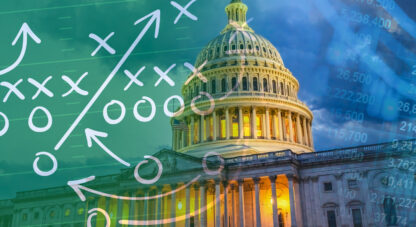An Interesting Situation
This week was an interesting one. After Wednesday’s FOMC meeting, it’s now fairly clear that Fed chair Powell’s Volker impression is officially over. Pretense and spectacle are Washington’s inside-the-Beltway specialties, but even in D.C. reality eventually wins out. This week, that reality emerged as the Fed appeared compelled to abandon the credibility-building Volker act in favor of dancing the latest round of the Potomac two-step.
According to Goldman Sachs, “November saw the largest easing in US financial conditions of any single month in the past four decades.” That easing of financial conditions in November was the result of markets celebrating the assumed end of the Fed’s policy tightening cycle, while simultaneously front-running the start of a much-anticipated easing cycle.
As HAI has pointed out for over a year, this market-based easing in financial conditions is counter-productive for the inflation fight. As such, each time the market has eased financial conditions since the start of the Fed’s policy tightening cycle, chair Powell has met the market with a stern voice or warning. In short, each time the market loosened financial conditions, Fed chair Powell pushed back with the threat that if markets continued to misbehave, more policy tightening (higher for longer) would be the consequence.
This pattern has held as recently as early December when chair Powell pushed back on the market’s November loosening by warning markets that it was “premature” to “speculate on when policy might ease” or to conclude that the Fed had “achieved a sufficiently restrictive [policy] stance” as of yet.
That was then, however. At this week’s FOMC, with markets still misbehaving (easing financial conditions), Powell caved rather than double down on his warning. The chairman instead said that rate cuts begin “to come into view” and that they are “clearly…a topic of discussion for us at our meeting today.”
The unexpected about face was enough to prompt Wall Street Journal reporter Nick Timiraos to say whimsically, “what a difference two weeks can make.”
Well, something changed in the last two weeks, but it wasn’t a dramatic change in the economic data. Nothing there would convince a “data dependent” Fed that an easing cycle is just what the doctor ordered.
In fact, the latest headline reading of the Consumer Price Index rose 0.1% for November. That was hotter than expected, and was up from an unchanged reading in October. That monthly increase came despite the fact that energy prices are falling aggressively and offering a substantial (if temporary) disinflationary tailwind to the data. Year-over-year headline CPI ticked down to 3.1% from 3.2% in line with expectations. Stripping out volatile food and energy prices, core CPI was up 0.3% M/M vs. a 0.2% gain the previous month. Year-over-year, core CPI remains stubbornly elevated at 4.0%, unchanged from last month and still double the Fed’s target rate. In short, the data wasn’t much of anything new. It argued that inflation remains sticky, vulnerable to reacceleration, and that policymakers should maintain the fight. CPI certainly wasn’t singing ding-dong, the inflation witch is dead.
So what caused Powell to change his tune so dramatically? HAI will speculate that it had less to do with economic data and far more to do with the new reality of policy whac-a-mole and the growing risk associated with a spiraling debt and deficit crisis.
Last week in the Financial Times, we had Nathan Sheets, the Global Chief Economist at Citigroup, describe a financial environment defined by what he called “heightened concerns about fiscal sustainability.” According to Mr. Sheets, the question he now gets asked more than any other is, who’s going to buy the government’s massive debt issuance?
Ultimately, Mr. Sheets had no answer. In his article, the chief economist concluded that what’s needed is an easing of the fiscal problem. However, according to Sheets, that would require a combination of higher taxes and spending cuts that are “unlikely to happen.” Even if tax hikes and spending cuts could be agreed upon, Sheets says, “the headwinds to growth that would likely accompany fiscal retracement are a further source of reluctance.”
In HAI’s view, Mr. Sheets is openly describing the whac-a-mole dynamic that is now overwhelming the goldilocks thesis, policymakers, and the financial asset confidence bubble. Policymakers face an array of problems, but every time they attempt to solve one of them, they face massive trade-offs.
We can think of goldilocks as a simultaneous combination of maintained economic growth, low-interest rates, low government interest expense, fiscal sustainability, low inflation, and stable bond and currency markets. Financial asset pricing currently reflects broad confidence on the part of market participants that policymakers will deliver a return to goldilocks in full.
However, it’s the interrelated nature of these elements that’s the problem. Addressing one of them comes at the expense of exacerbating others.
A Reuters headline this week was a case in point: “US budget deficit hits record high for November on interest costs.” In the article, Reuters reported that “The U.S. federal budget deficit jumped 26% in November from a year earlier to $314 billion, a record for the month…driven by sharply higher interest costs and other outlays.”
The article continued, “Outlays jumped $88 billion to $589 billion, 18% higher than a year earlier. Interest payments on U.S. government debt accounted for $25 billion of the increase.” Finally, Reuters notes that, “Debt service costs have surged since March 2022 when the Federal Reserve began raising borrowing costs sharply to rein in inflation.”
The government is addressing GDP growth concerns by deficit spending at breakneck pace. Simultaneously, they’ve raised interest rates to fight the surge in consumer price inflation. Instead of goldilocks, however, what we now get in its place are questions over who will buy the government’s massive debt issuance going forward, along with the following fact from Reuters; “The outlay for interest on the debt in November, at $80 billion, surpassed the $66 billion outlay for national defense.”
In short, we are conjuring GDP growth with massive deficit spending, and fighting inflation with high interest rates that are blowing out the interest component on debt. In the process, the government responses to both GDP growth and inflation are fast-tracking a debt and deficit doom loop and a resulting fiscal crisis. Pick your poison, but goldilocks is no longer on the menu.
HAI suspects that Powell’s about face on rate cuts and policy easing may reflect his acknowledgement that if interest rates remain at current high levels, we’ll exchange an inflation problem for an insolvency crisis. In other words, the interest rate brake as an inflation fighting monetary policy tool is effectively broken. If Powell follows through with premature rate cuts in 2024, interest expense will eventually fall, but only at the cost of inflation climbing. Goldilocks, meet whac-a-mole. Any D.C. policymaker insisting otherwise is just dancing the Potomac two-step.
Expect plenty of volatility as financial assets eventually adjust from expectations of confidence and goldilocks to our new environment. That adjustment process should prove price positive for gold as financial insurance, but it may not be good for much of anything else. As a result, for now, the yellow metal remains HAI’s highest-conviction bet.
On a separate allegorical note, and 26 frustrating hours into what was a scheduled six-hour itinerary, this author can attest that holiday travel isn’t always a joy. Holiday movies, however, always hit the spot.
While recently rewatching favorite holiday film It’s a Wonderful Life, this author couldn’t help but draw an analogy between one of the movie’s many classic scenes and our current set-up in the gold market.
In good old Bedford Falls, after Donna Reed loses her robe and scurries into the bushes, Jimmy Stewart says, “this is a very interesting situation” and notes that “a man doesn’t get into a situation like this very often.”
In HAI’s view, It’s a Wonderful Life offers us a wonderful analogy. Policymakers are set to reveal that the emperor has no clothes, it is indeed a “very interesting situation,” and certainly, it’s one gold investors don’t see very often.
With the era of unsustainable policies threatening to reach an untenable breaking point, and Powell ready to cave and prematurely pull the policy easing lever, gold is poised amid a set-up decades in the making to break out to the upside and deliver a fireworks show to remember.
As fund manager and HAI favorite Dan Oliver said this week, “Market commentators projecting a move to $2,200/oz or $2,500/oz once the all-time high is cleared convincingly are too timid. Gold bull markets, when they get going, typically run tenfold not ten percent.” A very interesting situation indeed.
PS: David McAlvany was kind enough to host this author on the McAlvany Weekly Commentary this week. For those interested in listening to the conversation, here is the link: https://mcalvany.com/fireworks-have-yet-to-begin-with-gold/.
Weekly performance: The S&P 500 gained 2.49%. Gold was up 1.05%. Silver gained 3.74%, platinum added 3.57%, and palladium surged 26.36%. The HUI gold miners index gained 3.98%. The IFRA iShares US Infrastructure ETF was higher by 3.38%. Energy commodities were volatile and mixed on the week. WTI crude oil was up 0.77%, while natural gas was off 3.45%. The CRB Commodity Index was up 0.86%, and copper was gained 1.57%. The Dow Jones US Specialty Real Estate Investment Trust Index was up 2.84%. The Vanguard Utilities ETF was up 0.96%. The dollar index was off 1.32% to close the week at 102.59. The yield on the 10-yr U.S. Treasury plummeted 31 bps to end the week at 3.98%.
Have a wonderful weekend!
Best Regards,
Morgan Lewis
Investment Strategist & Co-Portfolio Manager
MWM LLC















